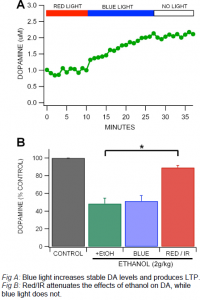Eliza Lee Warren and Dr. Scott C. Steffensen, Psychology and Neuroscience Center
Introduction:
Light therapy has been utilized to treat alcoholics in the past (Zalewska- Kaszubska & Obzejta, 2004), and opiate dependent rats (Mirzaii-Dizgah, Ojaghi, Sadeghipour-Roodsari, Karimian, & Sohanaki, 2009). Unfortunately, research is limited and still little is known. It was the aim of this study to determine what these effects are, specifically in the nucleus accumbens (NAc). Dopamine (DA) release in the shell of the NAc has been shown to be a contributing factor in addiction. As DA levels in the NAc are raised, behavior reinforcement occurs. Addictive drugs hijack this system by raising levels of DA in the NAc, and raising the threshold for brain stimulation reward. This results in a reduction in the excitability of the reward system and becomes a significant factor in forming addictive behavior. When addicts refrain from their addictive behavior, DA levels fall in the NAc, and so do the reinforcing feelings connected with them. This creates a powerful motivation to return to the addictive behavior, thereby raising DA levels and avoiding the depression associated with withdrawal (Di Chiara & Bassareo, 2007). If the tonic levels of DA in the NAc could be restored before such a critical point of deficiency, then relapse, depression, and the associated societal impacts could be more easily avoided. Low-level laser therapy prior to naloxone injection has proven to be an effective treatment for mitigating the effects of withdrawal for morphine-dependent rats (Mirzaii-Dizgah et al., 2009). A similar technique called near-infrared light treatment has also proved effective in restoring the function of dopaminergic cells in the substantia nigra pars compacta in mice, and is believed to have done so by increasing the efficiency for cellular functions (Shaw et al., 2010). These studies point to light radiation as a plausible therapy for addiction.
Methodology:
Isoflurane-anesthetized rats were placed in a stereotaxic apparatus, where holes were drilled in the cranium for insertion of stimulating and recording electrodes. A stimulating electrode was inserted in the medial forebrain bundle (MFB), while a carbon fiber electrode (CFE) was inserted in the NAc. We measured the release and reuptake of DA in the NAc using Fast Scan Cyclic Voltammetry (FSCV), an electrochemical method for measuring concentrations of compounds such as DA and serotonin. Then, we tested the effects of constant light, pulsed light, three wavelengths (IR, red, and blue), and at different intensities and frequencies. The light was applied with a DMX USB-controlled LED RGB illuminator controlled by LabVIEW software on PC computers. Light was applied first continuously to the whole head with a fiber optic cable applied just caudal to the eyes and aimed at the NAc. DA release was monitored before, during and after the light stimulation via FSCV. We also ran these procedures on anesthetized rats injected with ethanol (EtOH). In previous studies, our lab has found EtOH to have an inhibitory effect on DA release in the NAc. We tested red/IR and blue light to see if they attenuate the effect of EtOH on DA release in the NAc, and if DA response to light varied under EtOH and non-EtOH conditions.
Results:
In the absence of EtOH, we found that blue light has a greater effect on DA levels than red light (Fig. A), and that it produces long-term potentiation (LTP) of DA. However, when we tested EtOH-injected rats, we found blue light to have no effect, while red/IR significantly attenuated the effect of EtOH (Fig. B). Discussion: Our results show that both blue and red/IR light affect DA release in the NAc, though under different conditions. These findings have led us to a biochemical analysis of light and dopamine using spectrophotometry in order to better understand the mechanisms behind our results. If it is to be used as therapy, we need to first understand the underlying mechanisms.

Conclusion:
Our results show varying, yet promising, effects of light on DA LTP in the NAc. To further the possibilities of using light in addiction recovery treatment, we seek to understand its biochemical properties in further research.
